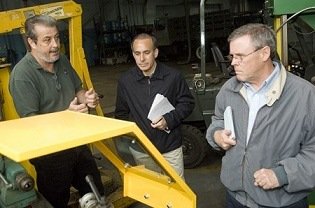Contents
Point of operation:-
That area in a machine where the material is positioned for recessing by the machine and where work is actually being performed on the material.
Zero Mechanic state (ZMS):-
 Mechanical state of a machine in which every power source that can produce a machine member movement has been Shut/locked off. This means d energized, pressurized a neutralized condition of machine or equipment which provides maximum protection against the unexpected mechanical movement.
Mechanical state of a machine in which every power source that can produce a machine member movement has been Shut/locked off. This means d energized, pressurized a neutralized condition of machine or equipment which provides maximum protection against the unexpected mechanical movement.
Power off:-
The state in which power (electric, pneumatic, hydraulic, atomic, etc.) cannot flow to the machine is considered a power-off stage.
Power-locked off:-
The state in which the device that turns the power off is locked in the off position with the padlock of every individual who is working on the machine.
Guarding:-
 Any means of effectively preventing personnel from coming in contact with the moving parts of machinery or equipment which could cause physical harm to the personnel. In case of a power-press, a cover on point of operation(die and punch) is called guard while those on other danger zones are called enclosure or safeguard.
Any means of effectively preventing personnel from coming in contact with the moving parts of machinery or equipment which could cause physical harm to the personnel. In case of a power-press, a cover on point of operation(die and punch) is called guard while those on other danger zones are called enclosure or safeguard.
Safety by guarding is most important as other methods are not always possible. Depending upon the dangerous part, its Size, position, speed, etc, a guard should be selected generally the parts to be guarded fall within three categories.
- 1.The prime mover,
- Transmission part form the, prime mover to the machine and the transmission parts in the machine itself. It is desirable to minimize them and enclose completely.
- Operating parts of a machine, which the points of dangerous operation need effective guarding.
A machine guarding:-
Means any sure, barrier or device constructed to prevent a person or his clothing coming into contact with dangerous parts of the machine. The point of operation is that part of the working machine at which cuffing, shaping, forming or any other necessary operation is accomplished. A guard for that part is known as the point of operation guard.
Enclosures:-
Guarding by fixed physical barriers that are mounted on or around a machine to prevent access to the moving parts.
Fencing:-
Guarding by means of a locked fence or rail enclosure which restricts access to the machine except by authorized personnel. Enclosures must be a minimum I m (42 in) away from the dangerous part of the machine.
Safety by Position or Location:-
It is a guarding as a result of the physical inaccessibility of a particular hazard under normal operating conditions or use. Words safe location or safe by position are used to denote safety by distance.
The words safe by position are used section-21 of the Factories Act. It means the situation (out of reach) or position in such a way that normally it is not possible to touch dangerous parts. However intentional should be prevented. Moving geed opening be made safe by position if gravity or remote feeding device is applied. But, then, it is of indirect guarding. A distance of 2.6 m or 8” , 6” is considered safe by position.
Ingoing (in-running) Nips:-
A hazard a created by two or more mechanical components in opposite directions in the same plane and in close conjunction or interaction calendar rolls, inuring rolls of textile or machines.
Safety by Construction:-
It indicates parts constructed as to cause no hazard, shift sliding and link mechanism so located or slow speed that their contact is not dangerous Built-in. safety is a similar word for the design and construction of new machinery in such a way to make the dangerous parts safe by housing or position etc.
Elimination of Hazard:-
Hazards form machinery are generally following types:
Crushing, shearing, cutting or seven entanglements, drawing-in or trapping, impact, stabbing or puncture, friction or abrasion, injection of mate from the machine, contact with moving part, hot sun or sharp edge, free fall of any material, tool equipment and high pressurized.
The basic steps to prevent accidents are:-
- Eliminate the hazard from the machine, method material, structure, etc.
- Control the hazard by enclosing or guarding at its source.
- Train personnel to know that hazard and follow the safe job method to avoid.
- Use personnel protective equipment necessary.
Thus machine guarding is one of the basic to eliminate hazard. Actually the machine should so designed and constructed that all safety points incorporated by built-in safety principle and necessary extra guards should be minimum.






Please share details of machine guarding principle and working methodology